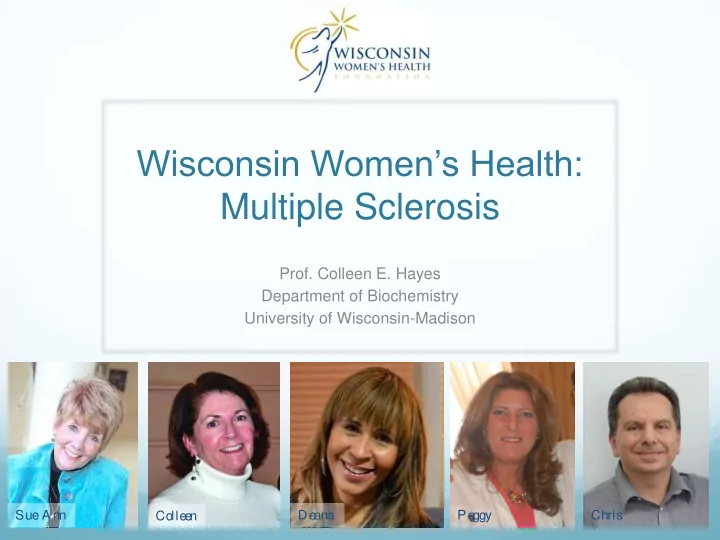

Wisconsin Women’s Health: Multiple Sclerosis Prof. Colleen E. Hayes Department of Biochemistry University of Wisconsin-Madison Sue A nn De ana Pe ggy Chris Colle e n
Multiple Sclerosis is an autoimmune disease Healthy nerve fiber with Demyelinated nerve fiber an intact myelin sheath with autoimmune lesions Credit: Seattle Children’s Hospital
For every disease there is a single key mechanism that dominates all others. If one can find it, and then think one’s way around it, one can control the disorder -Lewis Thomas Credit: Seattle Children’s Hospital
Knowing the single key mechanism in MS enabled researchers to control the disease Multiple Sclerosis Trust UK MS patients who took Agent X weekly for a year had 85% fewer new MRI lesions Soilu-Hanninen et al. J Neurol Neurosurg Psychiatry 83:565, 2012
Optic neuritis and multiple sclerosis Optic Normal neuritis vision 20% of MS patients experience painful visual loss as a first symptom 50% of optic neuritis patients develop MS Derakhshandi et al. 2013 Acta Neurologica Belgica 113:257-263
Knowing the single key mechanism in MS enabled researchers to control the disease Optic neuritis patients were BRAIN MRI PLACEBO AGENT X randomized to receive a Black holes 1.64 0.15 placebo or Agent X in a New T2 2.63 0.64 double-blind clinical study lesions Brain scans were performed New Gad 1.36 0 at the beginning and end of lesions the study Cortical 3.36 1.08 Agent X significantly reduced lesions black holes, lesions, and Juxtacortical 2.82 0.69 progression to MS lesions Derakhshandi et al. 2013 Acta Neurologica Belgica 113:257-263
Discovering the single key mechanism that enables us to control multiple sclerosis
1997: Scientific Reasoning Agent X is an environmental factor that determines whether people with genetic risk factors will develop multiple sclerosis If we aspire to control multiple sclerosis, we must discover what Agent X is and how it works Individuals at risk Environmental risk factor 10dailythings.com Aug 16, 2008
The risk of multiple sclerosis varies inversely with latitude and sunlight 0 o latitude: <2 MS cases/10 5 population >55 o latitude: >400 MS cases/10 5 population Sir Donald Acheson
Agent X is something we produce when we expose our skin to sunlight Winter Summer
The risk of multiple sclerosis varies inversely with fish consumption, overcoming a lack of sunlight Fish Finnmark County: consumption 73 MS cases/10 5 people J/m 2 Oslo: 136 MS cases/10 5 people Grytten et al. 2006 Neurology 66:182-186 Swank et al. 1952 N Engl J Med 246:722-728
Agent X is something we ingest when we consume fish “In Cod We Trust” -George Ebers
“ It is our hypothesis that one crucial environmental factor is the degree of sunlight exposure catalyzing the production of vitamin D 3 in skin, and, further, that the hormonal form of vitamin D 3 is a selective immune system regulator inhibiting this autoimmune disease ” Hayes, C.E. et al.. 1997, Fed. Proc. Soc. Exp. Biol. Med. 216:21
How does vitamin D 3 reduce brain lesions? Invading T lymphocytes astrocytes Blood vessel Invading immune cells Calcitriol The inflamed brain produces calcitriol, the hormonal form of vitamin D
Calcitriol causes invading immune cells to die
The non-inflamed brain repairs damaged tissue
One dose of the vitamin D hormone reversed demyelinating disease in rodents Treatment Disability Placebo Calcitriol Days Optic nerve sections No disease Diseased, placebo Diseased, calcitriol Nashold et al. J. Neuroimmunol. 263, 64-74, 2013
Vitamin D 3 confers health benefits beyond multiple sclerosis Type 1 diabetes Infectious disease All types of cancer including breast cancer Neurodegenerative disease including Alzheimer’s Disease Neuropsychiatric disorders including depression Cognition, memory, and learning Bone health
Would early, substantial, and consistent vitamin D 3 supplementation prevent a significant proportion of multiple sclerosis cases?
Special thanks for a quarter century of collaboration Ms. Faye Nashold Prof. George Ebers Sir Donald Acheson Department of Biochemistry Chair Emeritus Emeritus University of Wisconsin Department of Neurology Chief Medical Officer Madison, WI Oxford University United Kingdom Oxford, UK Research support: National Multiple Sclerosis Society, T. Wolfe and P. Powers
Recommend
More recommend